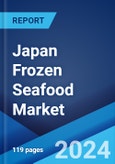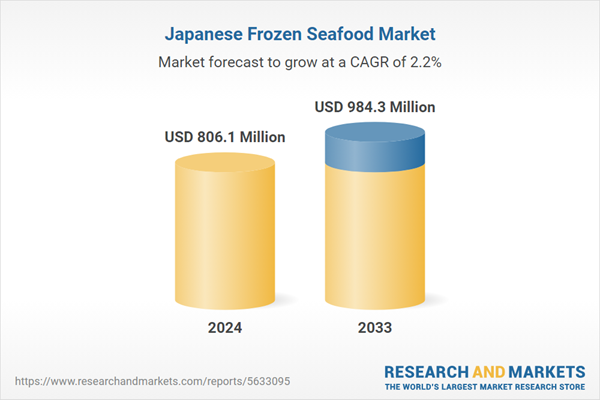The Japan frozen seafood market size reached USD 806.1 Million in 2024. Looking forward, the market is forecast to reach USD 984.3 Million by 2033, exhibiting a growth rate (CAGR) of 2.38% during 2025-2033.
The seafood products like fishes, fish fillets, shrimps, prawns, shellfish, etc. when subjected to freezing are known as frozen seafood products. Freezing helps to handle and transport the seafood safely and reduces the risk of foodborne illness by preventing the growth of pathogenic bacteria, parasites or other harmful germs in it. Thus, these products remain fresh, healthy, tasty and have nigh nutritional value compared to the non-frozen seafood products. They also help in lowering blood pressure, reduce the risk of heart problems and are packed in such a way that increases their overall shelf life and thus affordability and availability.
Japan currently represents one of the largest seafood markets globally. At present, the country ranks second in terms of per capita consumption of seafood worldwide. The seafood consumption is expected to increase further in Japan, especially shrimps. Another major factor driving the growth of Japan frozen seafood market is the rising demand for healthy food. Japan's population is aging faster as compared to other countries, thus, the demand for frozen seafood products that offer health benefits such as lowering cholesterol, micronutrients and essential fatty acids is anticipated to increase further. Moreover, the increasing number of small and single-person households and rising number of working women, is also boosting the frozen seafood industry in the country. Other factors that are expected to catalyze the market growth include- increasing trend of convenient products such as ready-to-eat meals/semi-processed products/easy-to-prepare fish products, changing lifestyles, new product launches, product premiumization and rising healthcare expenditures.
IMARC Group’s latest report provides a deep insight into the Japan frozen seafood market covering all its essential aspects. This ranges from macro overview of the market to micro details of the industry performance, recent trends, key market drivers and challenges, SWOT analysis, Porter’s five forces analysis, value chain analysis, etc. This report is a must-read for entrepreneurs, investors, researchers, consultants, business strategists, and all those who have any kind of stake or are planning to foray into the Japan frozen seafood market in any manner.
This report provides an analysis of the key trends in each segment of the Japan frozen seafood market report, along with forecasts for the period 2025-2033. The report has categorized the market based on type, distribution channel and sector.
What has been the impact of COVID-19 on the Japan frozen seafood market?
What is the breakup of Japan frozen seafood market based on the type?
What is the breakup of Japan frozen seafood market based on the sector?
What is the breakup of Japan frozen seafood market based on the distribution channel?
What are the various stages in the value chain of Japan frozen seafood market?
What are the key driving factors and challenges in Japan frozen seafood market?
What is the structure of Japan frozen seafood market and who are the key players?
What is the degree of competition in Japan frozen seafood market?
The seafood products like fishes, fish fillets, shrimps, prawns, shellfish, etc. when subjected to freezing are known as frozen seafood products. Freezing helps to handle and transport the seafood safely and reduces the risk of foodborne illness by preventing the growth of pathogenic bacteria, parasites or other harmful germs in it. Thus, these products remain fresh, healthy, tasty and have nigh nutritional value compared to the non-frozen seafood products. They also help in lowering blood pressure, reduce the risk of heart problems and are packed in such a way that increases their overall shelf life and thus affordability and availability.
Japan currently represents one of the largest seafood markets globally. At present, the country ranks second in terms of per capita consumption of seafood worldwide. The seafood consumption is expected to increase further in Japan, especially shrimps. Another major factor driving the growth of Japan frozen seafood market is the rising demand for healthy food. Japan's population is aging faster as compared to other countries, thus, the demand for frozen seafood products that offer health benefits such as lowering cholesterol, micronutrients and essential fatty acids is anticipated to increase further. Moreover, the increasing number of small and single-person households and rising number of working women, is also boosting the frozen seafood industry in the country. Other factors that are expected to catalyze the market growth include- increasing trend of convenient products such as ready-to-eat meals/semi-processed products/easy-to-prepare fish products, changing lifestyles, new product launches, product premiumization and rising healthcare expenditures.
IMARC Group’s latest report provides a deep insight into the Japan frozen seafood market covering all its essential aspects. This ranges from macro overview of the market to micro details of the industry performance, recent trends, key market drivers and challenges, SWOT analysis, Porter’s five forces analysis, value chain analysis, etc. This report is a must-read for entrepreneurs, investors, researchers, consultants, business strategists, and all those who have any kind of stake or are planning to foray into the Japan frozen seafood market in any manner.
Market Segmentation
This report provides an analysis of the key trends in each segment of the Japan frozen seafood market report, along with forecasts for the period 2025-2033. The report has categorized the market based on type, distribution channel and sector.Breakup by Type
- Pacific Salmon
- Tuna (bigeye)
- Mackerel
- Tuna (yellowfin)
- Octopus
- Crabs
- Trout
- Cuttlefish
- Jack and Horse Mackerel
- Other Frozen Fish
Breakup by Distribution Channel
- Supermarkets and Hypermarkets
- Convenience Stores
- Specialty Retailers
- Online
- Others
Breakup by Sector
- Retail
- Institutional
Competitive Landscape
The report has also examined the competitive landscape of the market and provides the profiles of the key players operating in the industry. Some of the major players include:- Kibun Foods Inc.
- Nippon Suisan Kaisha, Ltd.
- Marudai Food Co. Ltd.
- Maruha Nichiro Corporation
Key Questions Answered in This Report
How has the Japan frozen seafood market performed so far and how will it perform in the coming years?What has been the impact of COVID-19 on the Japan frozen seafood market?
What is the breakup of Japan frozen seafood market based on the type?
What is the breakup of Japan frozen seafood market based on the sector?
What is the breakup of Japan frozen seafood market based on the distribution channel?
What are the various stages in the value chain of Japan frozen seafood market?
What are the key driving factors and challenges in Japan frozen seafood market?
What is the structure of Japan frozen seafood market and who are the key players?
What is the degree of competition in Japan frozen seafood market?
Table of Contents
1 Preface3 Executive Summary
2 Scope and Methodology
4 Introduction
5 Japan Frozen Seafood Market
6 Market Breakup by Type
7 Market Breakup by Distribution Channel
8 Market Breakup by Sector
9 Competitive Landscape
List of Figures
List of Tables
Companies Mentioned
- Kibun Foods Inc.
- Nippon Suisan Kaisha Ltd.
- Marudai Food Co. Ltd.
- Maruha Nichiro Corporation
Methodology

LOADING...
Table Information
| Report Attribute | Details |
|---|---|
| No. of Pages | 141 |
| Published | February 2025 |
| Forecast Period | 2024 - 2033 |
| Estimated Market Value ( USD | $ 806.1 Million |
| Forecasted Market Value ( USD | $ 984.3 Million |
| Compound Annual Growth Rate | 2.2% |
| Regions Covered | Japan |
| No. of Companies Mentioned | 4 |









